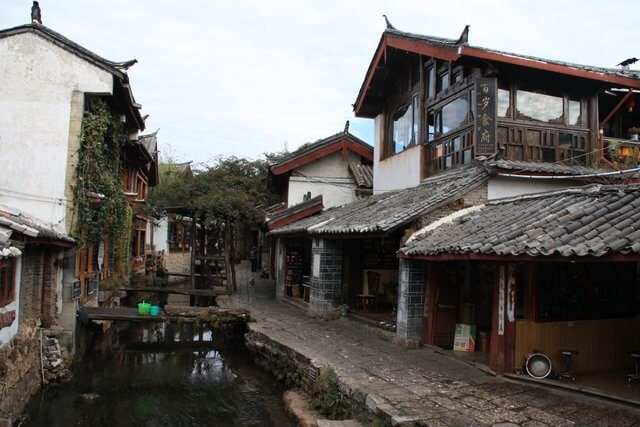
The ancient canals are a water-supply system providing the whole town with clear spring water.
History of Lijiang
Despite Lijiang’s 800 year history as a central point for the tea trade to Tibet, it only really became known in the west through a book written by an American commissioner who passed through Yunnan province in the late 19th century.
As China opened up in the 1980s, tourists followed the path described in the book and found a small hamlet often referred to as the prettiest town in China. Many foreigners stayed, dubbing Lijiang “The Venice of the East”, and numerous bars and restaurants opened up to accommodate them.
Lijiang was just as unknown to most Chinese until the 1990s, when the town was declare a UNESCO World Heritage site in the aftermath of the 1996 Sichuan earthquake. Since then, people from all over the world have been flocking to the tranquil lifestyle and clean air. This growth in tourism has raised prices and driven many of the original inhabitants away from the Old Town.
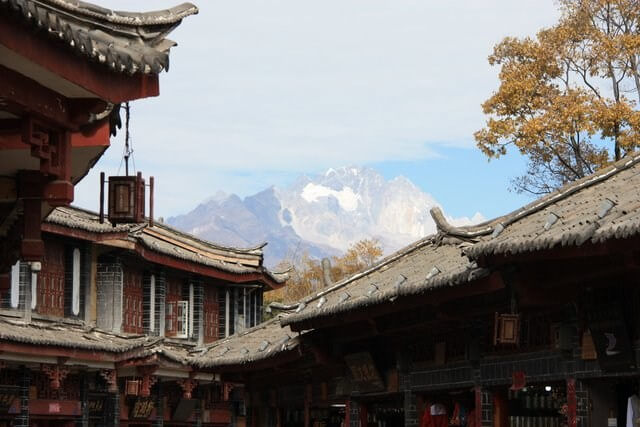
Jade Dragon Mountain, viewed from Lijiang Old Town. Lijiang is a temperate place to live, being sheltered from the cold wild by the Lion Mountain to the west and the Golden Row and Elephant Mountains to the north
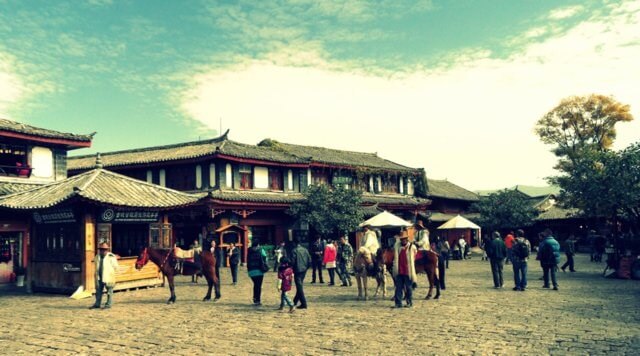
Riders wait in Square Street in Lijiang. This is the centre of the original Old Town.
Lijiang is now divided into the New and Old Town
The New Town is a relatively recent addition to Lijiang, built to house those priced out of their traditional homes in the Old Town. The poorly constructed buildings fared badly in the 1996 earthquakes, bringing the town to national attention. The New Town is still a bit of a mess, and not worth a visit, but does have the best hotels and restaurants.
The Old Town is further divided into the Ancient Old Town (the original part), the adjoining New Old Town (built in the same style to cash in on tourists) and the three surrounding towns of Dayan, Baisha and Shuhe.
The New Old Town is attractive enough, and merges beautifully into the Ancient Old Town, but every inch has been converted to shops and restaurants, so there’s no pretence that anyone still lives there.
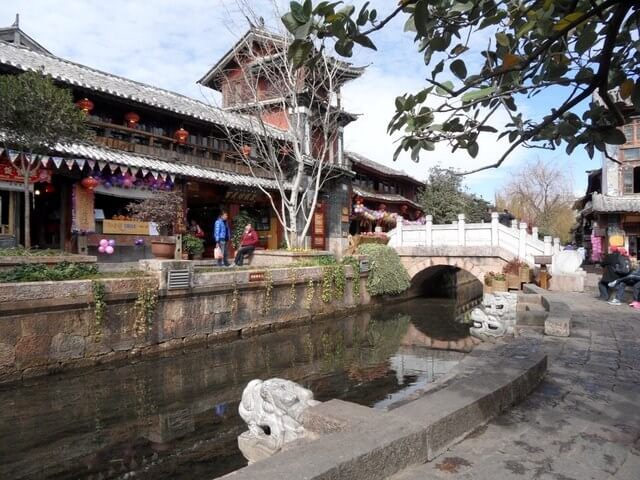
The stone arches and bridges around the central square were built during the Ming and Qing dynasties.
Fictional History of Lijiang
If you’ve read the Percy Jackson novels, they suggest that Lijiang is home to one of the Lost Legions of Rome, hence the name Lijiang, or “Li-gion”. Yep…
Similar claims have been made about a town in the west of China called Liqian, where the inhabitants at least have blonde hair and green eyes, although to date zero Roman artefacts have been found in the area.
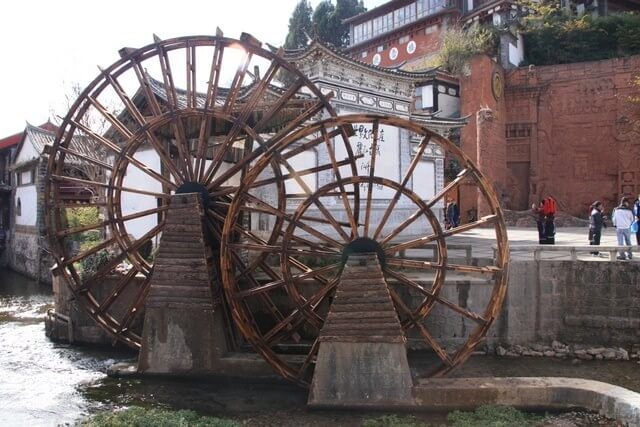
Waterwheels in Yuhu Square, Lijiang. These mark the edge of the Old Town. Yuhu Square is popular with dancers in the evening.
Lijiang is one of the few Chinese cities without walls
In Chinese culture a city should have a wall, for defence and for governance. The City of Lijiang is a rare exception to this rule, and there are two competing theories:
- The city used to be dominated by a man called mu(木). He worried that if walls were built around him he would be more like 困 or kun, meaning trapped.
- The local Naxi people descended from nomads, and felt that walls would be too restrictive.
Whichever you accept, it does mean it’s quite easy to accidentally wander a little too far in one direction, and find yourself in the equally bustling New Town.
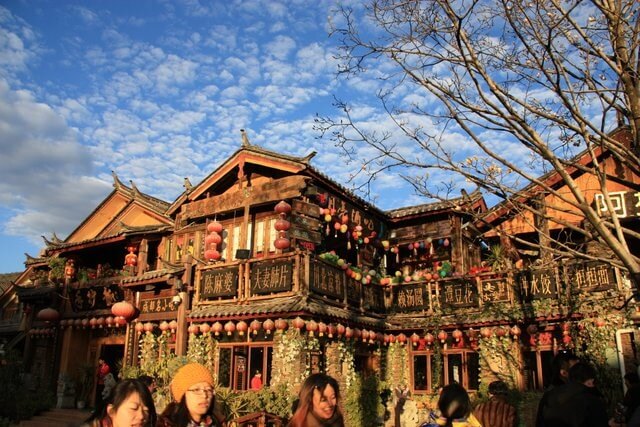
Across from the waterwheels, this Sichuan Restaurant in Lijiang Old Town marks the start of the walkway to the Black Dragon Pool
Lijiang Snack Street – better with (Chinese) friends
On the second day, my Chinese friend and I went for street snacks. In the middle of the Old Town there’s a dedicated snack street, popular with both foreign and domestic tourists. Delicacies on offer here range from local specialities like black goat meat, or yak skewers, to simpler fried potato dishes and spring rolls.
Everything was delicious. The food was hot, fresh and beautifully presented. The stallholders were friendly and happy to explain what some of the more obscure dishes contained.
Two days later, I went alone. Despite it being the same time of day, and in some cases the same stallholders, the food was mediocre at best; portions were smaller and all served as quickly as possible.
The following day, we went together again. This time the food was hot, fresh and beautifully presented. The stallholders were friendly and happy to explain what some of the more obscure dishes contained.
I guess the moral is to take a Chinese friend if you want the best food experience, even if you’re reasonably confident in your food-related Mandarin.

Lijiang Snack Street - A chinese friend may also recognise some of the meats on a stick
Lijiang Impressions
I think it was when I got lost and started wandering round the back streets it became clear how few people actually live there. Speaking to our hotel’s owner, it’s obvious that most people live in Lijiang New Town and commute in, which to me makes Lijiang Old Town more of a theme park than a town. He recommended visiting Shuhe to see what Lijiang was like a few years earlier, before the tourists and the bored city-dwellers moved in.
There’s nothing actually wrong with Lijiang – it’s a very attractive town, with some interesting food and many places to visit in the surrounding area. We went in the depths of the low season and it was still busy. Pictures taken in summer show it to be absolutely packed.
One note for Mandarin readers – being so far from Beijing, the shops were happy to sell quite a variety of books banned by the capital.






Pingback: East Asia Blog Round-Up : 22/1/2012 | Eye on East Asia
Pingback: Tiger Leaping Gorge Hike
Pingback: Shuhe Ancient Town, near Lijiang | You're Not From Around Here
Pingback: Lijiang Old Town Visitor Tips
Pingback: Xishuangbanna Dai Autonomous Prefecture - Yunnan Province | YNFAH